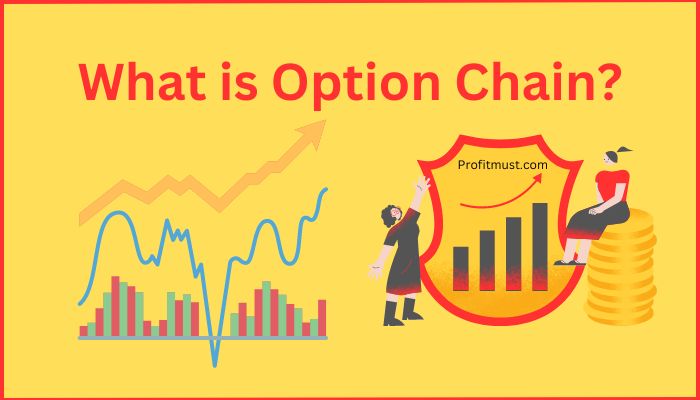Novice traders entering the world of options trading may find an options chain to be a complicated web of data. An option chain mainly refersto a chart offering comprehensive information on every stock contract available for the Nifty stocks.
What makes an option chain particularly useful is the way it provides valuable insights into the present security value and the way it may be impacted during the long run.
Having a good understanding of the option chain can aid investors in making the right decisions in the market. This post aims to provide a clear overview of the nifty 50-option chain to help traders make informed trading decisions.
Table of Contents
What Do You Mean by Options Chain?
The options chain is essentially a comprehensive list of all the option contracts available and is divided into two sections: put and call options. The call option gives the holder the right.
However, it will not give you the obligation to purchase an underlying asset at a specific price within the option’s expiration date.The put option, on the other hand, allows the holder the right to sell the underlying asset within the option’s expiration period, but not the responsibility to do so.
The stock that was acquired by the trader who would be willing to pay the stock price if it were permitted is referred to as the option strike. The call and put options for a particular security are also included in the list of option contracts in the option chain.
To examine the current market circumstances, however, some traders additionally pay attention to the “bid,” “net change,” “last price,” and “ask” columns.
The option chain, sometimes referred to as an option matrix, makes it simple for seasoned traders to spot changes in price. The option matrix enables users to look across and identify regions of high or low liquidity. Typically, it helps traders evaluate the liquidity and depth of specific strikes.

How to Analyze Option Chain?
To make informed decisions when trading options, analyzing the option chain is essential. Here are the steps involved in analyzing anifty 50-option chain:
Choose the underlying asset
Decide the underlying asset you wish to trade options on, such as a stock or index.
Check the expiration date: Option chains often include a number of potential dates. Pick an expiration date that fits with your trading strategy.
Check the put and call options
The option chain will also display the put and call options that generally comes with a certain expiration date. Always make sure to check the strike price, bid-ask spread, and most recent traded price.
Calculate option Greeks:
The option chain will also provide the Greeks, including delta, gamma, theta, and Vega. These Greeks indicate the option’s sensitivity to changes in the underlying asset’s price, volatility, time, and interest rates.
Analyze open interest and volume:
The open interest and volume of an option give an idea of trading activity. Higher open interest and volume suggest popularity among traders.
Consider implied volatility:
Implied volatility is an option’s expected volatility based on its current market price. Higher implied volatility implies a significant price movement expectation, while lower implied volatility suggests the opposite.
Formulate a trading strategy:
After analyzing the option chain, formulate a trading strategy that aligns with your risk appetite and market outlook.
Overall, analyzing the option chain involves examining multiple factors to identify the best trading opportunities.

Points to Remember about option chain
- A large discrepancy between the ask and bid prices denotes poor contract liquidity, whereas a small discrepancy denotes strong contract liquidity.
- An uptrend is indicated by an increasing last-traded price (LTP). A positive market mood is indicated if the market is on an upswing and open interest is also rising, which signals that new buyers are entering the market.
- When LTP rises but open interest falls, it might be a sign that either purchaser are liquidating their positions or short sellers are covering their positions. This indicates a pessimistic market mood since it signifies that money is being removed from the market.
- A declining LTP shows a downward tendency. Indicating a negative market mood is the market being in a downturn while open interest is also rising. This signals that new sellers are coming into the market.
- A greater percentage change denotes a significant rise or fall in LTP. When open interest is high, and LTP declines significantly, it may be a sign of panic since it shows that investors who had purchased the contract at a higher price are now losing money and are prepared to close out their holdings at lower prices.
Components of Options Chain Chart
The option chain generally includes four columns: net change, bid, ask, and last price. These columns provide essential information that can help traders evaluate the current market sentiment. Here are some key points to consider for a better understanding of the option chain:
- Net Change: It represents the difference between the current day’s closing price and the previous day’s closing price. A positive net change indicates that the price of the contract has increased, while a negative net change suggests a decrease.
- Bid Price: It represents the highest price that a buyer is willing to pay for the contract at a specific strike price and expiration date.
- Ask Price: It represents the lowest price that a seller is willing to accept for the contract at a specific strike price and expiration date.
- Last Price: It represents the most recent traded price for the contract at a specific strike price and expiration date.
By carefully analyzing these columns, traders can get a better understanding of the supply and demand for a specific option contract. This information can help them make informed decisions when trading options.

Conclusion
Even if the data provided in a chain option is valuable for trading the next day, one must consider other information sources and market indications before trading.
Additionally, they want to think about their trading prowess and assess how the current market emotion will affect them.In order to improve your investment selections and increase your chances of success, learning how to understand options chains is a crucial skill.
Frequently Asked Questions About What is Option Chain?
What is the benefit of option chain?
It works well for determining the liquidity and depth of particular strikes. Using the associated maturity date and strike price, it helps traders calculate the option premium. The option chain acts as a red flag for breakouts or sudden changes in the index or Stock.
What is option chain in simple words?
The listing of all option contracts is known as an options chain. There are two separate components included in it: call and put. Call options are contracts that grant you the right, but not the obligation, to purchase an underlying asset at a specific price and before the option expires. A put option, on the other hand, is a contract that grants you the right but not an obligation to sell an underlying asset at a specific price and before the option expires.
How do you predict market by option chain?
The classic indication that has been used for a very long time to determine the direction of the market is called PCR. The number of traded put options is divided by the number of traded call options to create this straightforward ratio. One of the most popular ratios to gauge investor sentiment for a market or share is this one.
How do I invest in option chain?
Accumulations in OI (open interest) and volumes at several option strikes can be used to develop an option chain trading strategy. It's important to keep in mind that open interest refers to the quantity that indicates how many open or outstanding options or futures contracts there are in the market at any given time.
How do you calculate profit in option chain?
Profit and Loss are determined by multiplying the number of lots sold by the premium's buying and selling prices. Obviously, 1500 less all required charges. For long put options that are squared off before to expiry, the P&L analysis is the same.

